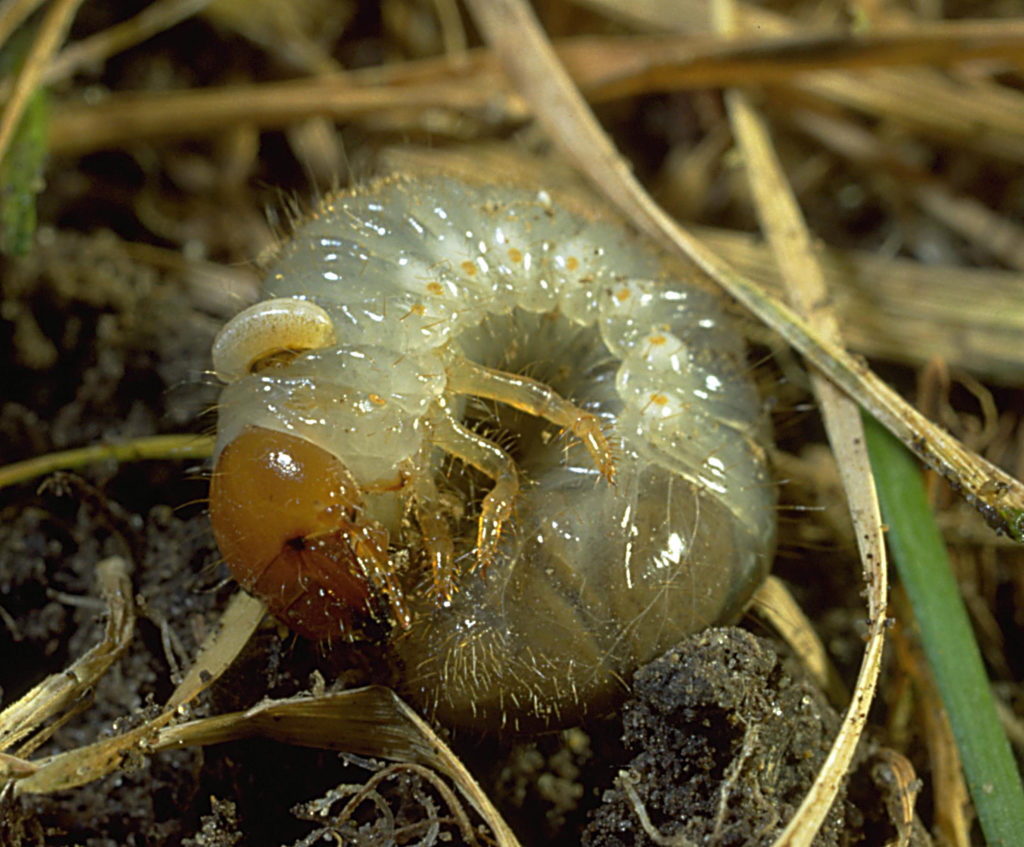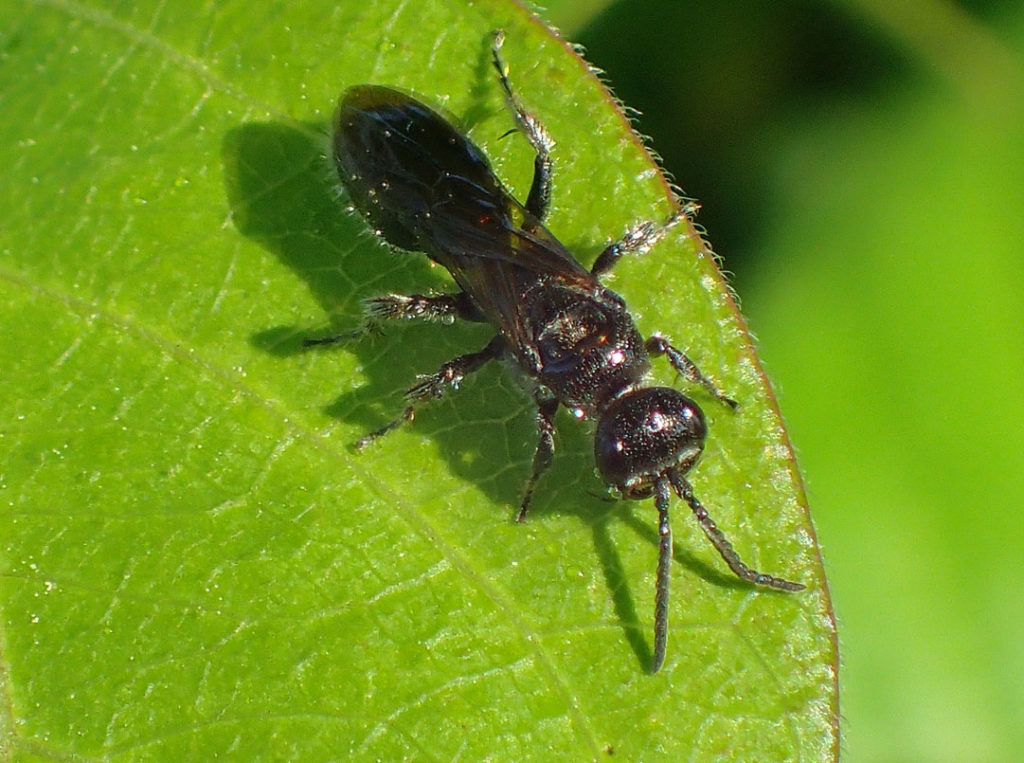Over the past two decades, since the Japanese beetle first became established in parts of eastern Colorado, it has proved very well adapted to life in Colorado’s irrigated landscapes. Presently it is most abundant and damaging in those areas where it has been established longest – south Denver/western Arapahoe counties, Boulder and Pueblo – but low populations may already be found in most urbanized areas along the Front Range.
Japanese beetle is an insect pest that is different from anything ever experienced in Colorado yards and gardens. To begin with, it should be considered almost two different insects, since very different damage is done by it different life stages. The immature form, a white grub, feeds on the roots of grasses in irrigated areas and can seriously damage turfgrass. The far more visible adults chew on leaves and flowers of a wide range of plants. Many of these are popular plants widely grown in the region, such as roses, certain lindens, Virginia creeper, and grape. Where Japanese beetle thrives, these plants become high-maintenance species, which are less attractive as landscape plant options.

At this point in time we are still at the early stages of Japanese beetle colonization of the Front Range. However, its ability to become a seriously damaging insect for landscape plants – probably the most damaging – has become clear with the experience of those living in areas where Japanese beetle has been present for a decade or more. And in these areas there comes the endlessly repeated question: “what can be done about the Japanese beetle?”
In the long term, biological controls may provide some relief. There are some natural enemies that attack Japanese beetles in the eastern United States and help reduce their numbers. These include certain insects that develop within Japanese beetles (parasitoids) and certain pathogens that produce disease. None of these came with the Japanese beetle when humans accidentally carried it to the various sites in Colorado where it has since established.
The biological control program for Japanese beetle being developed in Colorado is a “classical biological control” approach. The goal of this method is to identify natural enemies of the pest, then attempt to introduce them to areas where the pest has become newly established. Ideally, once established, the natural enemies will reproduce and spread on their own, ultimately suppressing populations of the pest. Over the past century, such an approach has been used effectively against hundreds of introduced insect pests, in some cases providing a permanent high level of control.
Three Natural Enemies of the Japanese Beetle
Since “classical biological control” involves purposefully introducing a new insect (natural enemy) that one hopes will become permanently established, it must be done carefully. Such programs are always done in coordination with government agencies (CDA, USDA APHIS) to ensure that the candidate biological control does not pose a threat to any native and desirable species in the release area. Three organisms are involved in the Colorado program for biological control of Japanese beetle. All have been present in parts of eastern North America for a long time, and none have ever been found to attack any other insect aside from the Japanese beetle.
- Ovavesicula popilliae is a type of fungus (microsporidian) that produces an infection of the excretory organs (Malpighian tubules) of the Japanese beetle. This produces a chronic disease that weakens the insect. Greatest effects seem to be related to the ability of Japanese beetle grubs to survive the stresses of winter and infected adults that do survive may live a shorter time and lay fewer eggs. In Michigan, spread of O. popilliae has been associated with steady reductions in Japanese beetle populations.
- Progress report: Ovavesicula popilliae has been acquired in the form of field collected beetles infected with the fungus that were frozen and shipped to Colorado. These are then blended into a slurry that contains spores of the fungus, and watered into turfgrass areas where large numbers of white grubs are present and feeding. To date, introductions have been attempted in 10 sites in Pueblo, Littleton, Cherry Hills, Denver, and Boulder. At one site, infections were confirmed two years after the release, indicating establishment.
- Istocheta aldrichi is a type of parasitic fly (Diptera: Tachinidae) that lays its eggs on the adult Japanese beetle. Upon hatching, the larva burrows into the adult, feeds internally, and ultimately kills the beetle. The full-grown larva then enters the soil and pupates. Adults emerge the following July.
- Progress report: The adult of Istocheta aldrichi requires sources of carbohydrates to survive and thrive. Its ability to be an effective natural enemy of the Japanese beetle is related to the presence of nearby nectar sources that the fly can feed on – small types of accessible flowers such as occur in the Apiaceae. To date, this fly was introduced in three sites (Pueblo, Denver and Littleton) during 2018 and one (Boulder) in 2019.

- Tiphia vernalis (spring tiphia) is a type of parasitic wasp (Hymenoptera: Tiphiidae) that lays its eggs on late-stage Japanese beetle grubs during May and early June. The developing larva of the wasp then consumes and kills the grub.
- Progress report: Like the parasitic fly, adults of Tiphia vernalis require nearby sources of carbohydrates to be effective. These can be provided by some flowering plants, but also from honeydew excreted by aphids and from extra-floral nectar that pools on buds of peony and some other plants. To date, Tiphia vernalis have been released in two years: by the Colorado Department of Agriculture in Littleton 2018 and 2019, and in Boulder in 2019.

Present plans are to continue to these releases during 2020 and beyond, and evaluate release sites to determine if and when they become established. New releases are to be done in a systematic manner that best covers areas, most highly infested and with conditions favorable to the successful establishment of the biological control organism, such as the presence of nearby nectar/carbohydrate sources needed for the fly and wasp. Much of the efforts to date have involved finding sources of the biological control organisms and planning for how they may be best used. These efforts have been successful, which should accelerate the program.
The biological control program for the Japanese beetle is still in its early stages, and it is too early to know how well any of the natural enemies will establish in Colorado and whether they will thrive and provide significant reductions in Japanese beetles over time. The beetles will not go away, but if the program is successful, perhaps a decade from now there may be only two or three beetles on a rose rather than the 10 that now may be found.
Editor’s note: Whitney Cranshaw has been working on management of insect pests of horticultural crops since 1983. He will be retiring from CSU at the end of July, but will continue to work on projects that he enjoys and have high value, such as the Japanese beetle biological control project. The biological control program for Japanese beetle in Colorado has been almost entirely privately funded over the past two years. Donations are welcomed. Checks should be made out to “Colorado State University Foundation”, and should reference Account #6451930 (Insect Research Hort Crops). For more information, Cranshaw can be reached at whitney.cranshaw@colostate.edu.










